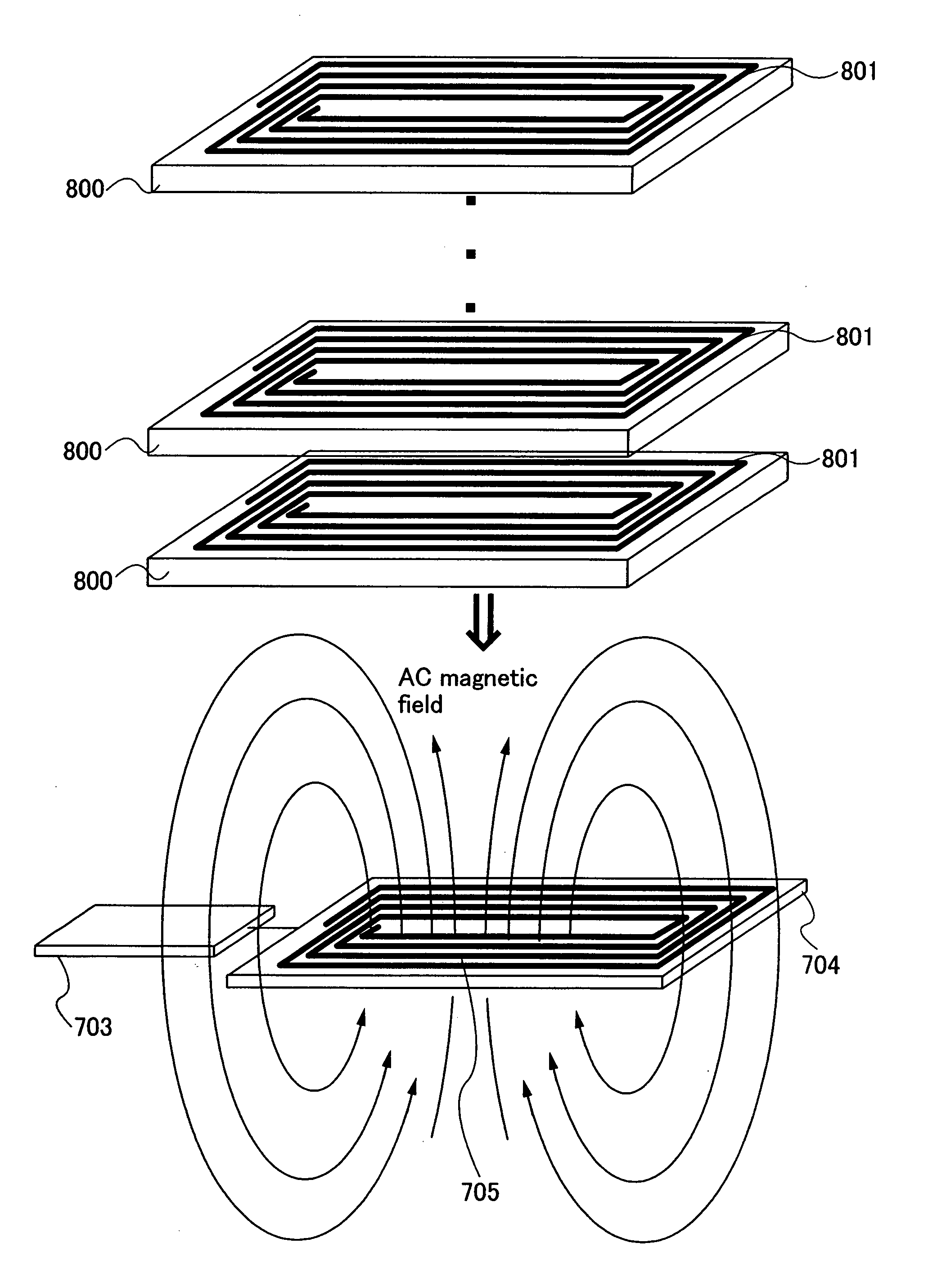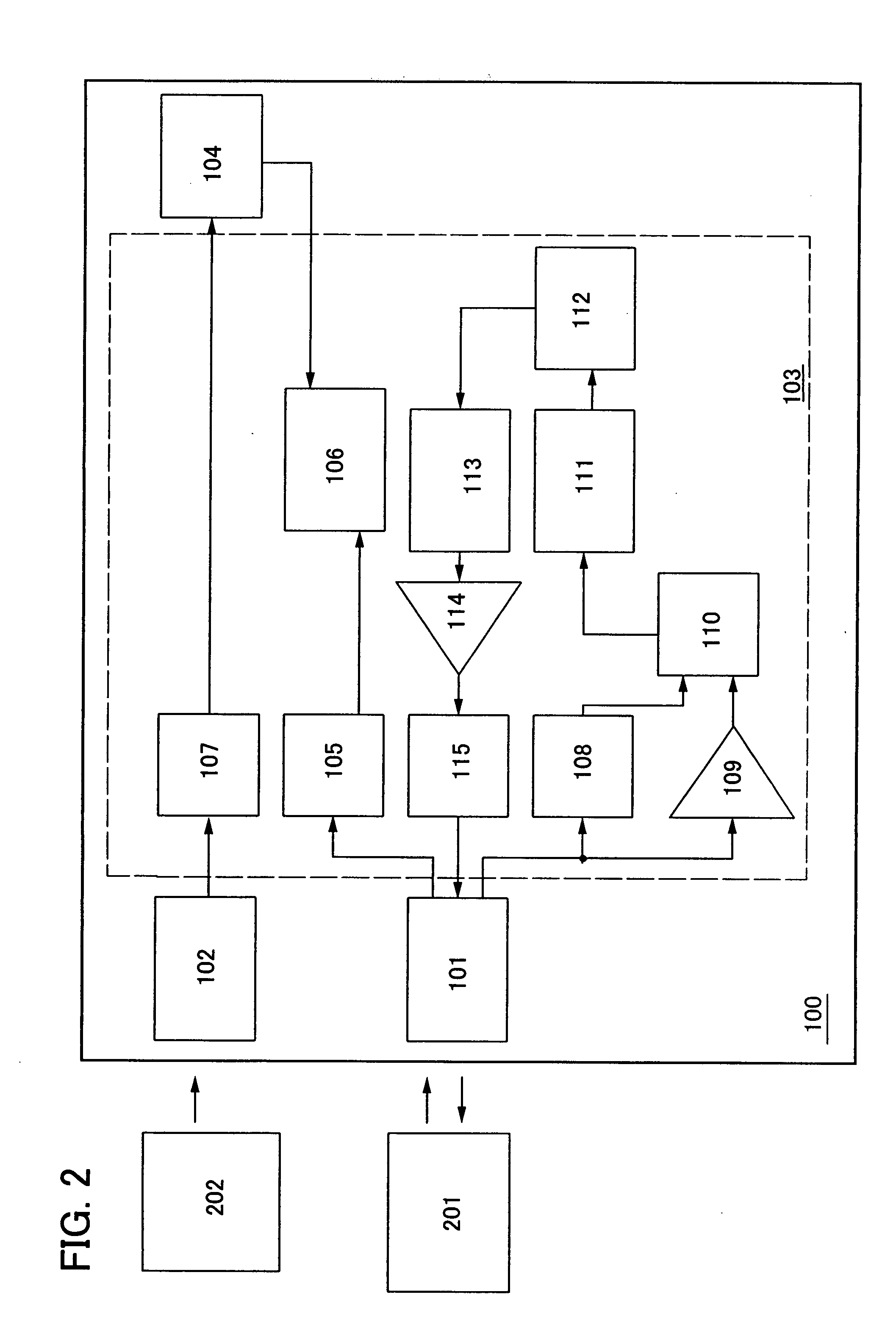Semiconductor device
a technology of semiconductors and devices, applied in the direction of burglar alarm mechanical actuation, burglar alarm by hand-portable articles removal, instruments, etc., can solve the problems of inability to generate the power required for transmitting and receiving individual information, difficult to transmit and receive signals from a long distance, etc., to prevent power shortages for transmitting and extend the communication distance between a reader/writer and the rfid.
- Summary
- Abstract
- Description
- Claims
- Application Information
AI Technical Summary
Benefits of technology
Problems solved by technology
Method used
Image
Examples
embodiment mode 1
[0058] A semiconductor device used for an RFID of the present invention will be described with reference to block diagrams shown in FIGS. 1 and 2.
[0059] An RFID 100 of FIG. 1 includes a first antenna circuit 101, a second antenna circuit 102, a signal processing circuit 103, and a battery 104. The signal processing circuit 103 includes a first rectifier circuit 105, a power supply circuit 106, a second rectifier circuit 107, a demodulation circuit 108, an amplifier 109, a logic circuit 110, a memory control circuit 111, a memory circuit 112, a logic circuit 113, an amplifier 114, and a modulation circuit 115.
[0060] In addition, FIG. 2 shows a block diagram in which the first antenna circuit 101 transmits and receives a signal to and from a reader / writer 201, and the second antenna circuit 102 receives a signal from a charger 202. In FIG. 2, the signal received by the first antenna circuit 101 is inputted to the power supply circuit 106 through the first rectifier circuit 105. In F...
embodiment mode 2
[0088] This embodiment mode will describe a structure having a booster antenna circuit (hereinafter referred to as a booster antenna) in a semiconductor device having the RFID shown in Embodiment Mode 1, with reference to drawings. Note that in the drawings which are used in this embodiment mode, the same reference numerals are used for the same portions as in Embodiment Mode 1.
[0089] Note that a booster antenna described in this embodiment mode means an antenna (hereinafter referred to as a booster antenna) which is larger than an antenna (hereinafter referred to as a first chip antenna or a first antenna circuit) which receives a signal from a reader / writer and outputs it to a signal processing circuit of an RFID included in a semiconductor device, or an antenna (hereinafter referred to as a second chip antenna or a second antenna circuit) which receives a signal from a charger included in the semiconductor device. The booster antenna and the first chip antenna or the second chip...
embodiment mode 3
[0117] This embodiment mode will describe an example of a method for manufacturing the semiconductor device shown in the above embodiment modes, with reference to drawings.
[0118] First, a release layer 1903 is formed over one surface of a substrate 1901 with an insulating film 1902 interposed therebetween, and sequentially, an insulating film 1904 which serves as a base film and a semiconductor film 1905 (a film containing amorphous silicon, for example) are stacked in FIG. 19A. Note that the insulating film 1902, the release layer 1903, the insulating film 1904, and the semiconductor film 1905 can be formed sequentially.
[0119] Note that as the substrate 1901, a glass substrate, a quartz substrate, a metal substrate (such as a ceramic substrate or a stainless steel substrate), or a semiconductor substrate such as a Si substrate can be used. In addition, as a plastic substrate, a substrate formed of polyethylene terephthalate (PET), polyethylene naphthalate (PEN), polyether sulfone...
PUM
 Login to View More
Login to View More Abstract
Description
Claims
Application Information
 Login to View More
Login to View More - R&D
- Intellectual Property
- Life Sciences
- Materials
- Tech Scout
- Unparalleled Data Quality
- Higher Quality Content
- 60% Fewer Hallucinations
Browse by: Latest US Patents, China's latest patents, Technical Efficacy Thesaurus, Application Domain, Technology Topic, Popular Technical Reports.
© 2025 PatSnap. All rights reserved.Legal|Privacy policy|Modern Slavery Act Transparency Statement|Sitemap|About US| Contact US: help@patsnap.com



